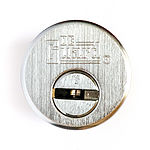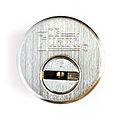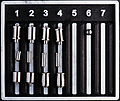DeGuard Interactive
DeGuard Interactive
| DeGuard Interactive | |
 | |
| Name | DeGuard Interactive |
|---|---|
| Manufacturer | DeGuard |
| Lock Type | Cylinder |
| Lock Design | Pin-tumbler, Dimple |
The DeGuard Interactive is a dimple lock made by DeGuard. It contains four or five pin stacks, depending on the length of the cylinder. It is a high-quality clone of the Mul-T-Lock Interactive. It contains telescoping pins (aka pin-in-pin) and includes additional security pins as both key pins and driver pins.
Principles of operation
The DeGuard Interactive utilizes dimple keys but functions the same as a standard pin-tumbler lock. The lock uses four or five chambers for telescoping pin-tumbler stacks which contain an inner pin nested within a second, larger one. In addition to it's telescoping pins, the Interactive utilizes a variety of security pins to deter picking. Driver pins are a mix of standard and spool designs. Outer key pins are both standard and torpedo pins. To open the lock, all 10 pin-tumblers must be aligned at the shear line. (See also Pin-tumbler, Principles of Operation)
DeGuard dimple keys are noticeably different from other dimple keys due to the mechanism of the lock. Each pin position has a pair of concentric cuts to match the inner and outer key pin lengths. The dimple key of the Interactive has five cut depths for outer pins and six, different cut depths for inner pins. The key is bitted on the sides and edges of the blade and is reversible
Disassembly instructions
The DeGuard Interactive is disassembled in the same way as a traditional pin-tumbler cylinder.
- Remove the rear plate (RIM/Mortise cylinder) or unscrew the retaining cap (KIK cylinder)
- Insert the key and turn the plug 30-45 degrees.
- Withdraw the plug from the cylinder. (A plug follower and core shims are strongly recommended)
- Care should be taken to keep the key pin pairs organized as outer pins of the same size may have different length inner pins.
Gallery
See also
| This article is a stub. You can help Lockwiki by expanding it. |




